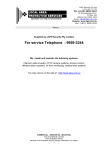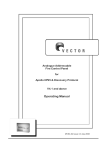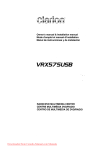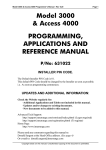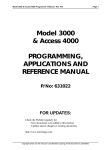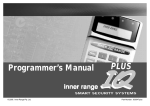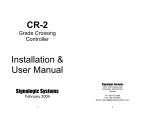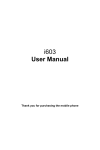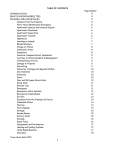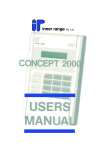Download NESS – 5000 User Manual
Transcript
5000 SERIES 8 ZONE INSTRUCTION MANUAL NESS SECURITY PRODUCTS 4/167 PROSPECT HIGHWAY SEVEN HILLS. 2147 NSW AUSTRALIA SYDNEY BRISBANE MELBOURNE PERTH Phone: Phone: Phone: Phone: (02) 8825 9222 (07) 3343 7744 (03) 9878 1022 (08) 9328 2511 (Head Office) To the best of our knowledge the information contained in this manual is correct at the time of going to print. NESS Security Products reserve the right to make changes so the features and specifications at any time and without notice in the course of product development. TABLE OF CONTENTS INTRODUCTION Terminology Features 5000 SERIES Optional Equipment Specifications CONTROLS AND INDICATIONS Keypad Audible Indications Visual Indications Zone Indications OPERATION 2 3 4 4 5 5 5 5 6 PROGRAMMING How to Enter Program Mode How to Program Access Codes Entry Delay Time Exit Delay Time Monitor Mode Type Zones to be Monitored Zones to Control the Auxiliary Output Programming Summary 6 6 7 7 8 8 9 9 9 General Information Operating Rules Arming the Control Panel Disarming the Control Panel Monitor Mode Emergency Functions Zone Expander Functions Alarms Resetting an Alarm Alarm Memory Excluding Zones Including Zones Auxiliary Output 10 10 10 11 11 12 12 13 13 13 14 14 14 TESTING AND TROUBLESHOOTING Testing Troubleshooting Guide Operation and Zone Summary 15 16 17 INTRODUCTION ****************************************************************************************************** Thank you for purchasing a NESS 5000 SERIES Control Panel. Please do not be frightened by its apparent complexity. The Panel is very powerful but also very easy to use and you only need to use as many or as few features as you require. At the very least, you need only know how to ARM and DISARM the Panel plus have a basic understanding of the indicators. Please take the time to read this manual so that you understand the full benefits of the 5000 SERIES Control Panel. 2 TERMINOLOGY ************************************************************************************************ The microcomputer based 8 Zone CONTROL PANEL forms the heart of your security system and connects to all other equipment. Each ZONE of the Panel will be connected to one or more detection devices to protect an area such as the front door, hallway, windows, etc. The Panel is said to be ARMED when it is set to detect an intruder. At other times it is DISARMED. Normally a zone is considered SECURED Activation of a detector will cause the zone to be UNSECURED and may cause an alarm. Detectors such as fire detectors and panic buttons must be able to generate an alarm at all times regardless of the Panel setting. A zone with this assignment is called a 24 HOUR ZONE. Before leaving the premises you must ARM the Panel to enable it to detect intruders and generate an alarm. After ARMING, the Panel will ignore most detectors for the EXIT DELAY TIME to enable you to depart without triggering an alarm. When you enter the premises the Panel will ignore selected zones for the ENTRY DELAY TIME and will not alarm unless you fail to DISARM the panel during this allowed time. If you wish to protect one area while you occupy another, MONITOR MODE allows selected zones to be Armed while leaving others Disarmed. The Control Panel housing and the metal covers over external sirens are protected by TAMPER switches to detect someone attempting to disable the security system. Activation of these switches will cause an instant TAMPER ALARM. If a detector becomes faulty, you can EXCLUDE the associated zone so that it is totally ignored and cannot generate an alarm. INCLUDING the zone will enable it to generate an alarm again. The Control Panel is fitted with a STAND-BY BATTERY to ensure your security system continues to operate it the MAINS POWER is interrupted. This battery is checked every hour and whenever you Arm the Panel. Whenever an alarm occurs, it may be silenced by entering an ACCESS CODE, otherwise it will reset at the end of RESET TIME. All alarms are stored in MEMORY and may be retrieved at any time by entering MEMORY MODE. 3 **************************************************************************************************** The 5000 SERIES 8 Zone Control Panel is one pan of an integrated range of equipment. Unique dynamic input system which will detect any component failure of the zone input circuitry and generates an alarm. 4 Access codes. Monitor mode (partial Arming). Simple operation allows selected zones to be Armed while others are ignored. Ideal for monitoring doors and windows while you are safe inside. Additional security is provided by the various programming options: - Arm via a code ALL inputs and outputs are heavily protected against lightning and high voltage power supply transients. An earth terminal is provided for extra protection. TRUE DYNAMIC BATTERY TEST under load, every hour and when Arming the panel. Your system will warn you in advance of possible battery failure. Works irrespective of whether the mains is on or off. - Exclude zones via a code - Indication of zones that are unsecured when arming. Special interface to allow the connection of NESS Remote Keypads which offer full programmability and operation of the panel from a remote location. Unique keyswitch input to allow simple remote operation of the Control Panel. Easy connection of the 5000 SERIES Satellite Siren to greatly increase the security of your system. The Control Panel housing has 4 separate tamper systems - Keypad, Wall, Lid and Panel impact. The panel impact tamper system protects against control panel intrusion by heavy impacts. These tampers are protected 24 hours a day. Different siren sound for 24-hour alarms Outputs are separately fused. A large 6.5 A-H backup battery and a 1.4 amp plug-pack transformer provides more than sufficient current to maintain the operation and security of the entire system, even under full alarm conditions. The mains input is constantly monitored. A warning is given when the mains is disconnected. Audible warnings to indicate trouble when Arming. Comprehensive Memory Mode for easy retrieval of important events such as Primary Alarms, Secondary Alarms, Tamper Alarms, Low Battery and Mains Fail. All Programming data is permanently stored in secure non-volatile EEPROM. 4 5000 SERIES OPTIONAL EQUIPMENT **************************************************************************** The following optional 5000 SERIES equipment is available for use with the 8 zone Control Panel. Remote Intelligent Keypad Remote or Intelligent Keypads can increase convenience of operation and security of your system. Remote Keyswitch The Remote keyswitch will simplify the operation of the Control Panel it is required. Satellite Siren Fitted with its own battery and electronics, a Satellite Siren will operate independently of the control panel if there is any interference to the system wiring. Telephone Auto Dialler The Telephone Auto Dialler allows the 5000 SERIES Control Panel to communicate alarms via your telephone line. Securitel Interface Unit Similar to the Telephone Auto Dialler but provides higher security. Radio Control Equipment A Radio Control Receiver can be connected to the Panel to receive signals from Radio Transmitters such as hand-held panic/emergency buttons. Real Time Event Recorder Printer This device is connected to the Panel to RECORD and/or PRINT when any activity takes place. Output Expander Provides 20 additional outputs for interfacing to other equipment. Zone Expander Provides an extra 16 Zones for the Panel. Dialler Remote Control This small hand-held device allows communication and remote control between you at a remote telephone and your Control Panel. Securitel is a Trademark of Telecom Australia. SPECIFICATIONS ********************************************************************************************** Construction Dimensions (mm) Weight (with 6.5 AH battery) Plug pack Power supply Quiescent Current Operating Voltage Rechargeable Battery Battery Charge Current Dynamic Battery Test 3mm Polycarbonate. 233 wide x 300 high x 85 deep. 3.3 kg. Input -240V AC. Output-17V AC. at 1.4A. 13.8 V DC. at 1.25 Amps, current limited. Less than 80 mA. 10 V to 15V DC. 12 V, 6.5AH. 450 mA maximum, current limited. Every hour and when the Panel is Armed. (whether mains power is on or off) Dynamic Battery Test Low Voltage 10.7 V with a 5A load. Fuses (5x20 mm) 4 x 1.5A, fast blow. Zone Inputs End-of-line resistor = 2200 plus/minus 900 ohms Remote Tamper Input Same as zone input. Remote Keyswitch / Panic Button Input Same as zone input. Remote Keypads' Inputs Proprietary. Intelligent Keypad Outputs Proprietary. Internal Siren Output Open collector, fused. External Siren Output Open collector, fused. Satellite Siren Output Proprietary. Maximum number of Sirens 3 x 8 ohm Ohm speakers (not including Satellite sirens since they have a separate siren driver circuit) Latched Alarm (Strobe) Output 1.5 A at 12 V, open collector, fused. Power Output for Optional Equipment With battery, 12 V, 1.5 A, fused. Resetting Alarm Output 1.5 A at 12 V, open collector, fused. 24 hour Alarm Output 100 mA at 12 V, open collector, current limited. Monitor Alarm Output 100 mA at 12 V, open collector, current limited. Auxiliary Output 50 mA at 5 V emitter follower, current limited. 5 CONTROLS AND INDICATIONS KEYPAD ****************************************************************************************************** The keypad consists of 12 buttons or keys. Each button of the keypad is used for three. purposes, a) to enter a number (eg. 1,2,3), b) to select a client programming option marked in blue (eg. CODE 1), c) to select a command marked in white (eg. ARM). The PROG (or P) button is used to begin any programming sequence. The END (or E) button is used in all cases to signify the end of the button sequence just pressed. AUDIBLE INDICATIONS ****************************************************************************************************** Every time a button is pressed the Panel responds with a very brief beep In acknowledgment. The beeper is also used to indicate whether the entry was valid or invalid. For example, whenever E is pressed, all the buttons pressed before it are checked to see whether they are valid. If they are valid, the response will be 3 short beeps. If they are invalid (or incorrect) the response will be 1 long beep and they will be ignored. At other times, the beeper will sound various warnings such as 10 beeps for a low battery. When Arming the Panel, 1-8 beeps will indicate that a zone is unsecured, eg. Zone 3 will be indicated by 3 long beeps. A continuous tone on Arming indicates a Tamper or 24-Hour zone is unsecured. During Entry time, it indicates that an alarm has occurred. VISUAL INDICATIONS ****************************************************************************************************** The panel has 16 indicator lights surrounding the keypad. Each light has three basic states to indicate function. These are: ON, OFF, FLASHING ARMED MONITOR ON The panel is Armed FLASHING The panel is in Monitor Mode OFF The panel is Disarmed ALARM MEMORY ON Memory mode is selected FLASHING FAST An alarm has occurred OFF No alarms FLASHING SLOW An alarm is stored in memory ZONE EXCLUDED ON The panel is in EXCLUDE mode FLASHING Zone(s) have been EXCLUDED OFF No zones are EXCLUDED PROGRAM OFF The panel is in normal operation mode. FLASHING SLOW The panel is in installer program mode. ON The panel is in client program mode. FLASHING FAST The program memory is faulty. BATTERY ON The panel battery is healthy. FLASHING The panel battery is low. (If flashing in unison with the satellite light, the satellite battery is low.) MAINS ON The mains power is connected and turned on. FLASHING The mains power is disconnected or turned off. TAMPER SATELLITE OFF The control panel and satellite siren tamper are secure and satellite siren battery is healthy. FLASHING The panel or satellite siren tamper are unsecured. If flashing in unison with the battery light, the satellite battery is low. LINE EXPAND OFF The dialler is inactive. FLASHING SLOW The dialler senses a phone line fault or a failure to communicate with the base station. ON The dialler has seized the phone line, a dialler or zone expander option is selected. FLASHING FAST The dialler or zone expander has a System fault, or the dialler cannot store the information just programmed into it. FLASHING at the incoming call rate. The dialler is detecting an incoming call. 6 ZONE INDICATIONS ****************************************************************************************************** FLASHING FAST Primary alarm ie. indicates the first zone to become unsecured and cause the alarm. There are 8 Zone indicator lights above the keypad. In normal operating mode they show the following states: . OFF Zone secured FLASHING SLOW Secondary alarm - ie. indicates those zones that have become unsecured during the Alarm Reset time. ON Zone unsecured As explained elsewhere in this manual, these zone lights are used to indicate other information in the Memory, Exclude, Monitor, Installation and Client Program modes. PROGRAMMING HOW TO ENTER PROGRAM MODE ****************************************************************************************************** The program Mode is entered whenever programming options are to be changed. IMPORTANT: The Control Panel will automatically exit the Program Mode if no keys are pressed within a two minute period. TO ENTER PROGRAM MODE, PRESS (PROG) (MASTER CODE) (END) The Program light will be illuminated. HOW TO PROGRAM ****************************************************************************************************** Programming the NESS 5000 SERIES 8 zone Control Panel is achieved via the keypad on the front. Every time a button is pressed, the panel responds with a very brief beep in acknowledgment. Each button is used for three purposes, The PROG or P button is used in the selection of PROGRAM mode, and thereafter in the selection of the option to be programmed. a) to enter a number (eg. 1,2,3), The END or E button is used in all cases to signify the end of the button sequence just pressed. b) to select a programming option c) to select a command (eg. ARM). Note: that programming options can only be selected whilst in PROGRAM mode. Programming of options can be carried out in any order. Visual feedback of the options programmed is achieved by illuminating the zone indicator lights or flashing the BATTERY/ MAINS light. The particular type of indications are described with the setting of each option in the following pages. All Programming follows this pattern Select your option and VIEW the current value ENTER the new value(s) (PROG) (OPTION) (END) (VALUE) (END) One long beep indicates an invalid entry. 7 ACCESS CODES *********************************************************************************************** The control Panel may be programmed with up to 4 separate Access Codes. Therefore each user may be allocated with their own unique code for higher security. REMEMBER Access CODE 1 (master code) MUST be programmed. All codes must contain a minimum of 3 digits to a maximum of 6 digits and must not begin with a zero. 1) To program code 1 to be, say, 3456, then enter: P 1 E 3456 E 3456 E 2) To program code 2 to be, say, 9765, then enter: P 2 E 9765 E 9765 E 3) To CANCEL code 2, then enter: P 2 E 09765 E 09765 E Codes 2,3 and 4 are optional. A code may be cancelled by beginning the code with zero. As a security measure, the existing code will not be displayed and the new code must be entered twice. If the second entry differs from the first, the existing code will remain unchanged. To input Code 1 ENTER (PROG) (1) (END) (_ _ _ _ ) (END) (_ _ _ _ ) (END) (_ _ _ _ ) Represents the numbers required as the code. To input Code 2 ENTER (PROG) (2) (END) (_ _ _ _ ) (END) (_ _ _ _ ) (END) (_ _ _ _ ) Represents the numbers required as the code. Access Codes 3 and 4 are programmed as above. ENTRY DELAY TIME ****************************************************************************************************** The Entry Delay Time is the time the Control Panel gives you to disarm the Panel after a delay zone is unsecured. For maximum security, the Entry Delay Time should be as short as possible. The Entry Delay Time can be set to a minimum of 1 second up to a maximum of 99 seconds. 1. To view the current Entry Delay Time, enter: P5E 2. The value programmed will be displayed via the zone (1-8), battery (9) and mains (0) lights. The display of the current value must be complete before a new value can be entered. 3. To change the current value to say, 10 seconds enter: 10 E Zone 1 light will flash on for 1 second followed by the MAINS light (0) to indicate the new value To VIEW the Entry Delay Time ENTER (PROG) (5) (END) To CHANGE the Entry Delay Time ENTER (VALUE) (END) 8 EXIT DELAY TIME ****************************************************************************************************** The Exit Delay Time is the time the Control Panel gives you to secure and depart the premises after the Panel is Armed. 1. To view the current Exit Delay Time, enter: P 6E The Exit Delay Time should be just long enough to allow departure comfortably without rushing and making mistakes. 2. The value programmed will be displayed via the zone (1-8), battery (9) and mains (0) lights. This display of the current value must be complete before a new value can be entered. The Exit Delay Time can be set to a minimum of 1 second up to a maximum of 99 seconds. 3. To change the current value to say, 80 seconds enter: 80 E Zone 8 light will flash on for 1 second followed by the MAINS light (0) to indicate the new value To VIEW Exit Delay Time ENTER (PROG) (6) (END) To CHANGE Exit Delay Time ENTER (VALUE) (END) MONITOR MODE 'TYPE ****************************************************************************************************** The 8 zone Control Panel provides an unique Monitor mode to ensure your security even while the Panel is disarmed and the premises are occupied. The 4 different types of Monitor mode alarms are: Typically, Monitor mode is used to monitor the perimeter zones (doors, windows) of a house while the occupants are at home or to monitor entry through front doors or fire doors in shops and offices while the premises are in use. 2 = Beeper and siren operate for 2 seconds only. Use this for medium security warnings or as a walk test mode. You can program which zones are to be monitored as well as select 1 of 4 different types of Monitor alarms. 1 = Beeper warning for the duration of the panel entry time, then full siren alarm. Used for perimeter protection. 3 = Full siren alarm immediately. Use this for high security, such as monitoring fire doors etc. 4 = Zone number is beeped out only. Use this for door opened warning. To select, say, Monitor mode 3, enter: P7E 3E When the above option is programmed into the panel, zone light 3 will flash on for 1 second. Talk to your security installation company about your specific requirements. To VIEW Monitor Mode Type ENTER (PROG) (7) (END) To CHANGE Monitor Mode Type ENTER (VALUE) (END) 9 ZONES TO BE MONITORED ****************************************************************************************************** Any zone can be selected for operation in Monitor mode. However, do not select a zone that has been installed to generate a 24 hour alarm (eg. Fire Detector). To program, say, zones 3 and 4 to be Monitor zones, enter, To remove a zone from the Monitor mode selection, re-enter the zone number. As each zone is programmed, the corresponding zone light is illuminated (if it was previously off). If the zone light was previously on, it will be extinguished, thus de-selecting that zone from Monitor mode. To VIEW Zones to be monitored ENTER (PROG) (8) (END) To CHANGE zones to be monitored ENTER (ZONE NUMBER) (END) P8E 2E 3E 4E ZONES TO CONTROL THE AUXILIARY OUTPUT ****************************************************************************************************** The 8 Zone Control Panel provides an Auxiliary output which can be turned on and off by ANY selected zones or via the keypad. This output can be used for a variety of applications. Talk to your security installation company about your specific requirements. To program, say, zones 4, 6 and 8 to control the Auxiliary Output, enter: P9E 4E 6E 8E As each zone is programmed, the corresponding zone light is illuminated (if it was previously off). If the zone light was previously on, it will be extinguished, thus de-selecting that zone. A zone programmed for Auxiliary will cause the Auxiliary Output to turn on when it becomes unsecured, regardless of whether the Panel is Armed or Disarmed. To remove a zone from the selection, re-enter the zone number of the zone to be removed. The output can also be turned on or off (toggled) by pressing 9 E while Disarmed or in Monitor mode. To VIEW Auxiliary Zones ENTER To CHANGE Auxiliary Zone(s) ENTER. (PROG) (9) (END) (ZONE NUMBER) (END) PROGRAMMING SUMMARY ****************************************************************************************************** DESCRIPTION OPTION Code 1 Code 2 Code 3 Code 4 P1E code E code E P2E code E code E P3E code E code E P4E code E code E Entry Delay Time Exit Delay Time Monitor Type Monitor Zones Aux Output Zones P5E time E P6E time E P7E type E P6E zone E P9E zone E DEFAULT 20 secs 60 secs Type 2 All Zones All Zones PROGRAMMED (1-99) (1-99) (1-4) (1-8) (1-8) 10 OPERATION GENERAL INFORMATION ****************************************************************************************************** This section describes the operation of a typical Control Panel installation. Keep in mind that your installation may vary depending on the selected options and equipment. The Control Panel is normally operated via the keypad on the front of the Panel or the optional Remote Keypad, or the optional Intelligent Remote Keypad. The operating instructions which follow will endeavour to cover the most common options. If you have any doubts speak to your Installer. OPERATING RULES ****************************************************************************************************** The various operations that can be performed are indicated in white on the top of the relevant buttons, (eg. memory). The optional keyswitch is operated by turning it clockwise (until it stops) momentarily. Generally, the Panel will be in the Disarmed, Armed or Monitor modes which provide different levels of security for your premises. If you make a MISTAKE while entering any codes, press the END (E) button and start again. Three other temporary modes, Program, Memory and Exclude, allow you to perform various operations. The Panel will automatically exit from these temporary modes it you do not press any buttons on the keypad within a 2 minute period. When you are required to enter your Access code, you are given THREE opportunities to enter it correctly. After the third invalid attempt the alarm is activated (requiring the correct code to silence the alarm). This prevents anyone trying to guess your code by entering random numbers. ARMING THE CONTROL PANEL ****************************************************************************************************** The Control panel must be ARMED prior to vacating the premises in order to detect intruders. There are three methods of Arming the Panel. a) Normally the panel is ARMED by entering on the keypad 0E Ensure that the Panel is not in Program, Memory or Exclude modes. b) However, your Installer may have programmed the Panel to require the entry of a code to Arm the Panel. 0 (CODE) E NOTE: If the panel is already in alarm, you must first silence the alarm before you can Arm. c) If the optional keyswitch is connected, this is turned momentarily to ARM the Panel. 1. CHECK that all windows and doors are securely locked. 2. Enter (0) (END) or (0) (CODE) (END) 3. The ARMED light should be ON and the keypad should beep 3 times. 4. Leave the premises within your Exit Delay Time. 5. At the end of the Exit Delay Time, three beeps will indicate successful Arming. If something is wrong when Arming the control panel, the normal 3 beeps will be replaced by other warnings; 10 BEEPS Indicates either a Mains fault, Control Panel Battery fault or Satellite Siren Battery fault. LONG BEEPS Warn that a zone is unsecured. Eg. 4 long beeps if zone 4 is unsecured. CONSTANT TONE Indicates a 24 hour zone is unsecured. (Tamper, Panic or 24 hour zone.) 11 SIREN WARNING At the end of the Exit Time, all zones should be secured. If any are unsecured, the siren will sound as a warning to indicate that those zones have been automatically Excluded. For maximum security, you should return, DISARM, check the premises and then ARM again. Continual warnings could mean that a detector is faulty and may have to be manually Excluded. If the Auto Exclude option is disabled, the siren will sound continuously if a zone is unsecured at the end of Exit Time. DISARMING THE CONTROL PANEL ****************************************************************************************************** Upon entering the protected premises through a delay zone, the Control Panel responds with BEEPS AT ONE SECOND INTERVALS as a reminder to Disarm. You then have your programmed Entry Delay Time to Disarm the Panel by either: a) Entering one of your access codes and END, OR If one of your codes is, say, 7676 then to Disarm, enter 7676 E If you make a mistake in entering your code, then you must press E and start again. Three incorrect entries will cause an alarm. b) Activating the keyswitch. If the Panel is not Disarmed by the end of the Entry Delay Time, an alarm will occur. You may still enter your code to silence the alarm. 1. ENTER the protected premises via a DELAY ZONE. 2. LISTEN for the beeps coming from the panel. 3. Enter (CODE) (END) 4. The ARMED light should now be extinguished. A Continuous beep on entry is a warning that an alarm occurred while the Control Panel was Armed, the external strobe light (If fitted) will also be flashing as a reminder. The 1 second entry beeps (not the continuous warning) can be disabled as a function of the installation options. MONITOR MODE ****************************************************************************************************** Monitor mode allows you to ARM selected zones while others are ignored. Typically, Perimeter zones (doors and windows) can be Monitored while the occupants are at home. Monitor mode cannot be selected while in Program memory or Exclude modes. To select MONITOR mode, either a) Enter (CODE) E to DISARM, OR a) Press 8E, OR b) Activate the keyswitch momentarily to DISARM, OR b) If you are using a Remote Keyswitch, first Arm the Panel (by turning the keyswitch once), then turn the keyswitch twice within 2 seconds. The Control Panel will respond with 3 beeps and the Armed/Monitor indicator will FLASH to indicate that you are in Monitor mode. To EXIT from monitor mode, either c) Enter 0E, or 0 (CODE) E, to ARM the Panel. NOTE: If an alarm occurs, while in Monitor mode, silence the alarm by entering (CODE) E or activate the keyswitch. If an alarm does occur in Monitor mode, the zone light will remain flashing as a memory until you exit Monitor mode. 12 EMERGENCY FUNCTIONS ****************************************************************************************************** For personal protection, the Control Panel contains an INSTANT panic feature. Panic can be used to; a) Audible - Activates sirens and will transmit the alarm signal if monitored. b) Silent - Will transmit the alarm signal if monitored remotely. Scare away intruders inside or outside your premises. To activate emergency alarms: Summon help from friends or neighbours. MEDICAL FIRE PANIC Test the operation of the siren. enter enter enter 1E 2E 3E Three Emergency functions exist: To SILENCE the siren, you must enter: (CODE) E MEDICAL. A silent alarm that is only used if the Alarm system is monitored remotely (eg. Central Station). Panic cannot be used while the Panel is in Program, Memory or Exclude mode FIRE. An audible alarm that activates sirens and will transmit the alarm signal if monitored remotely (eg. Central Station). If you have the optional Remote Keyswitch, press the separate panic button fitted above the keyswitch. PANIC. This function may have been programmed to be either; EMERGENCY! 1. ENTER 3E 2. ENTER (CODE) EThe siren will stop. The siren will sound. ZONE EXPANDER FUNCTIONS ****************************************************************************************************** These buttons are ONLY USED in conjunction with the NESS 5000 Series Zone Expander to address the sixteen additional zones. (4) (END) Address first additional bank of 8 zone (6) (END) Address the second bank of 8 zones 13 ALARMS ****************************************************************************************************** Alarms may be caused by one of the following condition * A Zone has been activated while the Panel was Armed. * A Tamper circuit has been activated. * A Panic button has been activated. * A 24 Hour Zone has been activated. All of these can cause your sirens and strobe to operate. Various visual indications relevant to the alarm will be retained in the memory. If this occurs, disarm your Control Panel which will silence and reset the alarm. The cause of the alarm can be identified by entering the Alarm Memory Mode as described under ALARM MEMORY. RESETTING AN ALARM ****************************************************************************************************** Your Panel can be reset and the alarm silenced by entering your CODE followed by the END button. Alternatively, if a keyswitch is installed, the Panel may be reset by momentarily activating the keyswitch. If you arrive at your premises and find the strobe light flashing (if installed), reset the panel as below. Refer to the description listed under ALARM MEMORY, to help you interpret the flashing lights on the panel and what they mean. Enter (CODE) (END) ALARM MEMORY ****************************************************************************************************** The 8 Zone Control Panel contains a comprehensive Alarm Memory to show those alarms that occurred while the Panel was last armed. To view the MEMORY display, enter This Memory display may only be selected while the Panel is In the Disarmed, Monitor or Armed modes. 5E The Panel will respond with 3 beeps, the ALARM/MEMORY light will be illuminated and the other indicators will change to show the alarms, if any. 1. To View Memory press (5) (END) 2. Observe lights, 3. To Exit press (END) The Indicators are used as follows: ZONE LIGHTS FAST FLASH SLOW FLASH for a primary alarm, ie. point of entry. for a secondary alarm, ie. other zones entered by the intruder. ARMED LIGHT FLASHING for a Panic or Code alarm. TAMPER LIGHT FLASHING for a Tamper alarm, ie. Siren Cover, Satellite Siren etc. BATTERY LIGHT FLASHING for a low battery. MAINS LIGHT FLASHING for a Mains failure. BATTERY & TAMPER LIGHTS FLASHING for a Satellite low battery. 14 EXCLUDING ZONES ****************************************************************************************************** If a detector becomes faulty and cannot be secured when Arming the Panel, then its zone may be excluded, ie. ignored by the system so that it does not generate false alarms. Zones can only be excluded during the EXIT DELAY All the lights will be turned off and then the Zone Excluded light will show a steady light. You may now exclude zones. To exclude say, zones 4 and 8 after Arming, To enter the Exclude mode, FIRST ARM THE PANEL and then press 7E. 7E 4E 8E E Zone lights 4 and 8 will turn on. 1. ARM the Panel. 2. Press (7) (END) 3. Enter the zone(s) to be EXCLUDED (ZONE) (END) (ZONE) (END) 4. To Exit and save Exclusion (END) If you make a mistake, enter the zones number again to remove it from your selection. Zones which you exclude will be indicated by the relevant zone light Showing a steady light in the exclude mode. Premises can achieve a higher level of security by partially arming the control panel when people still occupy some areas To do this first Arm the Panel and then exclude those zones those zones and depart the premises. The exit delay time will be automatically re- enabled allowing them time to depart. INCLUDING ZONES ****************************************************************************************************** Zones which have been Excluded, may be included while you are in the Armed, Disarm or Monitor modes. All Excluded zones are automatically Included when the panel is Disarmed. Thus if a detector is still faulty it must be Excluded again. The main reason for providing the capability to include zones, is to allow an easy means for employees working back to include their own areas on leaving the premises. The Exit Time will re-start automatically. Pressing 7E will light the zone lights for the zones that have been Excluded. To Include, say, zones 4 and 8 press, 7E 4E 8E E Zone lights 4 and 8 will turn off. 1. Press 2. Enter the zone(s) to be INCLUDED 3. To Exit and save Inclusion (7) (END) (ZONE) (END) (ZONE) (END) (END) An attempt to include a zone which has not already been excluded, will result in one long beep and the zone remains unchanged. If you make a mistake selecting a zone to Include, it is not possible to exclude that zone, without returning to the Exclude Zone option AUXILIARY OUTPUT ****************************************************************************************************** Any or all zones may be assigned to control the Auxiliary Output. While any of these zone(s) are unsecured, the Auxiliary output will be turned on Thus all zones must be secured for the Auxiliary output to be turned off. By using the keypad it is possible to over-ride the zones controlling the output. If the output is on, press 9E and it will turn off. Press 9E again and it will turn on. Enter, * (9) (END) You cannot change the Auxiliary output while in the Program, Memory or Exclude mode 15 TESTING AND TROUBLE SHOOTING TESTING ****************************************************************************************************** To ensure the integrity of your security system, it should be checked on a regular basis. YOU can carry out any of the tests outlined below or engage a qualified Technician from a licensed Alarm Company to carry out a more technical assessment according to Australian Standards AS.2201.1 9.2 MAINTENANCE (extract AS.22O1.1) 9.2.1 Routine maintenance. 9.2.1.1 General Routine maintenance visits to the alarmed premises shall be made by an authorised representative of an alarm company at a minimum rate of twice per year with no more than 7 months between visits. WALK TEST To check correct operation of all zones (indicated by a 2 second siren and beeper warning). NOTE: Programming described in steps 14 are normal default values. Therefore these steps may be bypassed if Monitor mode is not being used and has not been reprogrammed. P (CODE) E 1. Enter Program mode P 7E 2E 2. Select Monitor mode 2 3. Set all the zones to Monitor zones. P 8E 1E 2E 3E 4E 5E 6E 7E 8E. (Select only those zones whose lights are not lit.) Remember: If your system is connected to a Central Monitoring station, please advise them prior to carrying out any of these tests. 4. Exit the client Program mode PE SIREN TEST 5. Select Monitor mode. - Enter 2 E, Siren will sound Now move around your premises and unsecured each detector in turn. The siren will operate for 2 seconds each time a detector is unsealed. When you have tested all detectors, check the control panel to ensure that all zone indicators are flashing ie. all zones have been tested. - To reset siren Enter (CODE) E. SYSTEM CHECK Ensure that all zones are secured and then, 8E. -ARM Panel. 0E or O (CODE) E. -Wait for exit time to expire - trigger any Instant zone and the siren should sound, OR trigger a Delay zone - wait for the entry time to expire and the siren should sound - Reset the panel (CODE) E. 6. EXIT FROM MONITOR MODE by disarming the panel. 7. Don't forget to re-program the Monitor mode type, and Monitor zones back to their normal settings. 16 TROUBLE SHOOTING GUIDE ****************************************************************************************************** SYMPTOM POSSIBLE CAUSE CORRECTIVE ACTION Zone light on or long beeps on Arming. Zone detection device (eg. reed switch, movement detector) unsecured. Number of beeps determine which zone is unsecured. Close door or window. Find cause of movement. 10 beeps upon Arming. Mains light flashing Battery light flashing. Mains power off. Battery low. Check plug pack is plugged in and power point on, or call Installation Company. 10 Beeps at any time (mains / battery light flashing) (as above) (as above) 1 long beep during keypad entry. Invalid keypad entry. Press END button and reenter. Constant tone upon Arming. Tamper, panic or 24 hour zone unsecured. Check panic button (If installed), or call Installation Company. 2 second siren at end of exit time. Zone unsecured before expiry of exit time. Re-enter premises, disarm system, check zone isolate memory to determine zone Constant tone on entering premises. Alarm occurrence since last arming of panel. Check Alarm memory to determine zone at fault. External strobe light flashing. Alarm occurrence since last arming of panel. Check Alarm memory to determine zone at fault. Siren sounding when system disarmed. Tamper, panic or 24 hour zone activated. Reset alarm by entering code or activating keyswitch, check panic buttons (if installed), or call Installation Company. Armed/monitor light flashing. Monitor mode entered by mistake. Exit monitor mode. Zone Excluded light flashing. A zone has been excluded. Check zone excluded memory. Arm panel with all zones secured. Tamper light flashing. Tamper unsecured. Call Installation Company. Alarm memory light flashing. Alarm in memory. Check alarm memory to see cause of alarm. 17 OPERATION SUMMARY ****************************************************************************************************** ARM 0 E or 0 (CODE) E or Keyswitch DISARM (CODE) Eor Keyswitch RESET ALARM (CODE) Eor Keyswitch MONITOR MODE 8E Exit MONITOR MODE (CODE) Eor OE ALARM MEMORY Exit MEMORY 5E E EXCLUDE ZONES Exit EXCLUDE MODE ARM as above, then 7E zone E zone E etc. E INCLUDE ZONES Exit INCLUDE MODE 7E zone E zone E etc. E PANIC ALARM 3E CHANGE AUXILIARY OUTPUT 9E or Keyswitch ZONE SUMMARY ****************************************************************************************************** TYPE LOCATION ZONE 1 ________ ________ Z0NE 2 ________ ________ ZONE 3 ________ ________ Z0NE 4 ________ ________ ZONE 5 ________ ________ ZONE 6 ________ ________ ZONE 7 ________ ________ ZONE 8 ________ ________

















